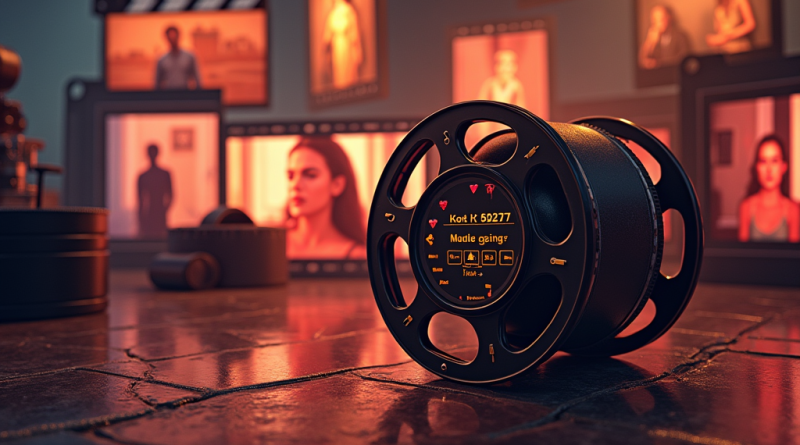Kodak 100T 5247 LUT: Film Emulation for Modern Cinematography
Kodak 100T 5247 is a motion picture film stock that has been iconic in the history of cinema. It has been used in several major film productions for its unique color profile, high sensitivity, and fine grain quality. Although it is no longer in production, modern cinematographers and video editors can still capture its distinctive look using a Kodak 100T 5247 LUT (Look-Up Table). A LUT is a color grading tool that allows filmmakers to replicate the aesthetic of specific film stocks digitally. In this article, we will explore what the Kodak 100T 5247 LUT is, its applications, how it works, and why it continues to be popular among video professionals.
The History Behind Kodak 100T 5247 Film Stock
Before delving into the digital LUT world, it’s essential to understand the legacy of Kodak 100T 5247. This particular stock was introduced by Kodak in the 1970s and became a favorite for filmmakers due to its exceptional performance in tungsten lighting conditions. It was considered highly sensitive to light (ISO 100), which made it ideal for indoor scenes or locations with controlled lighting. Over the years, several iconic films were shot on this stock, establishing its reputation in the industry.
Films shot with Kodak 100T 5247 are known for their rich contrast, vibrant colors, and faithful skin tone reproduction. Its popularity continued through the 1980s and early 1990s before it was eventually discontinued to make way for newer film stocks. Nevertheless, filmmakers who loved the look of 100T 5247 wanted to preserve its characteristics, which led to the creation of LUTs that digitally replicate this film stock’s signature look.
What Is a Kodak 100T 5247 LUT?
A Kodak 100T 5247 LUT is a preset color grading tool that mimics the visual characteristics of the original Kodak 100T 5247 film. LUTs are widely used in post-production to apply a specific color scheme to digital footage, transforming modern footage to resemble older film stocks. A Kodak 100T 5247 LUT captures the colors, contrast, and dynamic range of the original film stock, allowing video creators to give their projects a nostalgic, cinematic feel.
LUTs are applied in video editing software such as Adobe Premiere Pro, Final Cut Pro, DaVinci Resolve, and others. They act as a mathematical formula that alters the color values of the video, ensuring that the final result closely resembles the chosen look—in this case, Kodak 100T 5247 film stock.
How to Apply a Kodak 100T 5247 LUT
Applying a Kodak 100T 5247 LUT to your video is straightforward if you are familiar with video editing software. Here’s a step-by-step guide:
- Choose Your Footage: LUTs work best on footage that is either shot in a flat or log profile. This allows for more flexibility during the color grading process, ensuring that the LUT’s colors are properly applied.
- Import the LUT: Most video editing software will allow you to import LUTs. In Adobe Premiere Pro, for instance, you can navigate to the “Color” panel, select “Input LUT,” and choose your Kodak 100T 5247 LUT file.
- Apply and Adjust: Once applied, you may need to tweak the intensity of the LUT to suit your footage. This ensures that the look doesn’t overpower the original shot while still giving it that film-like quality.
- Fine-Tune Colors: After applying the LUT, you can further adjust color settings such as exposure, white balance, and contrast to perfect the look.
Why Use Kodak 100T 5247 LUT for Modern Projects?
The allure of the Kodak 100T 5247 LUT lies in its ability to transport the viewer back to the golden age of cinema. There’s a growing trend of using film emulation LUTs in modern cinematography to evoke nostalgia and give digital projects an organic feel. Here are some reasons why filmmakers and editors choose this LUT:
- Nostalgia Factor: Film lovers appreciate the look and feel of classic cinema, and Kodak 100T 5247 is a popular choice for recreating that retro aesthetic.
- Cinematic Depth: Digital footage can often appear too sharp or sterile. Applying a LUT such as Kodak 100T 5247 introduces depth, with smoother transitions between light and shadow and a softer color palette.
- Skin Tone Accuracy: One of the standout features of Kodak 100T 5247 film stock was its ability to render natural, warm skin tones, which is crucial in portrait and narrative filmmaking. The LUT preserves this strength.
- Enhanced Storytelling: The look of Kodak 100T 5247 LUT adds a unique texture and warmth to the narrative, helping to set a specific mood or tone that enhances the storytelling.
Popular Uses of Kodak 100T 5247 LUT
The Kodak 100T 5247 LUT has various applications in modern videography and cinematography:
- Short Films: Independent filmmakers often use this LUT to give their low-budget films a professional, high-quality finish reminiscent of classic cinema.
- Music Videos: Music videos often call for visually striking and unique aesthetics, and the Kodak 100T 5247 LUT delivers a nostalgic, emotional impact that suits certain genres well.
- Documentaries: When telling historical stories or pieces rooted in the past, editors use this LUT to give footage an authentic look that helps transport viewers to the desired era.
- Commercials: Advertisers sometimes use the Kodak 100T 5247 LUT for campaigns that aim to evoke a vintage or timeless look, appealing to audiences’ sense of nostalgia.
How the Kodak 100T 5247 LUT Differs from Other LUTs
The Kodak 100T 5247 LUT stands out from other film emulation LUTs due to its specific color profile and historical significance. While there are many LUTs that emulate film stocks like Kodak Vision3 or FujiFilm, Kodak 100T 5247 has a very distinct aesthetic, especially when working under tungsten lighting conditions.
Some key differences include:
- Warmer Color Temperature: Unlike LUTs designed for daylight-balanced film stocks, the Kodak 100T 5247 LUT thrives in warmer, tungsten-lit scenes. This makes it ideal for indoor shooting or evening scenes.
- Finer Grain Representation: Although digital footage doesn’t inherently have film grain, this LUT can be paired with additional grain effects to simulate the fine grain structure that Kodak 100T 5247 was known for.
- Rich Contrast: Kodak 100T 5247 LUT maintains the strong contrast of the original film stock, making it suitable for high-contrast scenes where dynamic range is essential.
Conclusion
In an era where digital filmmaking dominates, there’s still a place for the aesthetics of film. The Kodak 100T 5247 LUT allows filmmakers to revive the vintage charm of this beloved film stock without the complexities of shooting on film. Whether you’re working on a short film, a music video, or a documentary, using a Kodak 100T 5247 LUT can give your project a cinematic, nostalgic look that transports audiences to a different time. With its warmer color profile, rich contrast, and accurate skin tones, this LUT continues to be a favorite among filmmakers and video editors who want to add a classic film look to their digital footage.
7 Frequently Asked Questions About Kodak 100T 5247 LUT
- What type of projects benefit the most from using the Kodak 100T 5247 LUT?
- This LUT is perfect for narrative films, music videos, commercials, and documentaries that aim to evoke a classic, nostalgic look.
- Can I use the Kodak 100T 5247 LUT on any type of footage?
- Yes, but it’s most effective when applied to footage shot in a flat or log profile, which allows more flexibility during color grading.
- How do I install and use the Kodak 100T 5247 LUT in video editing software?
- Installation varies by software, but most allow you to import the LUT through the color grading panel. Adjustments may be needed after applying.
- Does the Kodak 100T 5247 LUT work for outdoor scenes?
- While primarily designed for tungsten lighting, you can still apply this LUT to outdoor scenes, but it may require further adjustment.
- Is it possible to combine this LUT with other color grading techniques?
- Absolutely. Many editors use this LUT as a base and then fine-tune their footage with additional color grading tools.
- Can the Kodak 100T 5247 LUT be used for live video production?
- Typically, LUTs are used in post-production, but they can also be applied in live video feeds, depending on the equipment and software.
- Are there different versions of the Kodak 100T 5247 LUT?
- Some creators offer slight variations of the LUT, such as those optimized for specific lighting conditions or paired with grain effects to better emulate the original film stock.




